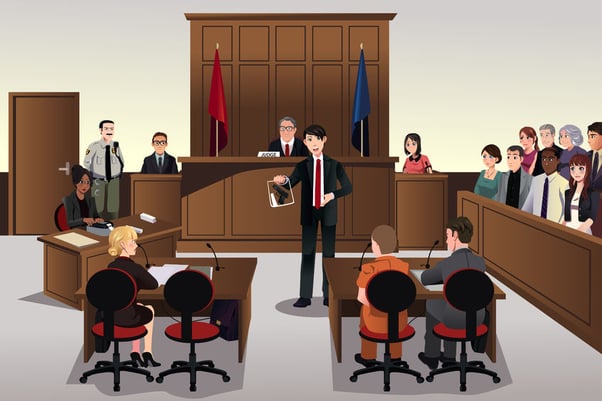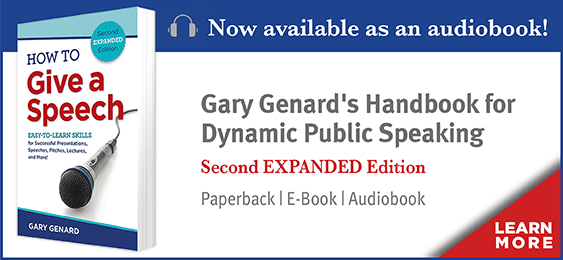 You know that body language is interesting to observe. But are you aware of how powerful your movement and gestures can be?
You know that body language is interesting to observe. But are you aware of how powerful your movement and gestures can be?
“Suit the action to the word, the word to the action,” advised Hamlet, adding that a speaker mustn’t “overstep the modesty of nature.” Sounds simple enough, doesn’t it?
But as we consider movement and gestures as part of courtroom performance, what exactly does it mean to match a physical action to the words one is speaking? What kind of action is Hamlet talking about? After all, Elizabethan England and twenty-first century courtrooms alike have witnessed speakers aplenty who “saw the air too much with their hands,” and give their listeners too much of the “whirlwind of their passions.”
How we move and gesture when we talk about important topics—a category that certainly includes court cases—has been a challenging area for speakers through the ages. We recognize that our body’s relationship to space is a critical component of convincing our listeners. As J. Michael Sproule put it in his book Speechmaking, “the visual dimension of public speaking is directly linked to rhetorical success.”
But that knowledge alone doesn’t lessen the sheer jitters and self-consciousness this area always seems to conjure up in speakers. As with most things in life, however, the challenge of reinforcing and amplifying your advocacy though movement and gesture is equaled only by the rewards available for mastering it.
Let’s look at three practical skill areas that can help you use movement and gestures powerfully in the courtroom:
Why Movement Matters in Public Speaking
When most people think about the physical nature of their presentations, they tend to focus on the question, “What in the world do I do with my hands?” Aside from gestures, however, the courtroom offers one of the few venues where the lawyer can use the more powerful tool of movement effectively.
Public speakers are often confined behind a lectern, a situation that applies to some courtrooms as well. When you aren’t confined in this way, however, you have a marvelous palette at your disposal: all of the space in the trial area in which you are able to move. A moment’s reflection should remind you that this represents a true opportunity, exactly like the actor’s “center stage” on which you can dramatically present your client’s case. And that means moving as well as speaking!
Even in those venues where you must remain behind a lectern, you can use movement at strategic times: to approach an exhibit, to show a witness something with the court’s permission, to “re-check” your notes at counsel’s table. The point is, once you are comfortable moving around the trial area, you can take the further (dramatic) step of making movement part of your arsenal of persuasion: in opening statement, testimony, closing argument, and even voir dire. Using movement effectively just might make your opponent look stiff and flat-footed.
The Importance of Gestures When You Speak
Gestures are another invaluable tool for dramatizing your case’s presentation. Imagine speaking to someone you care about concerning something you’re passionately interested in, while keeping your hands at your side and staying as still as a cigar-store Indian. You wouldn’t be half as convincing as you would be if you gestured effectively, would you? Gestures clarify your ideas, support your assertions, give vitality and emphasis to your words, and in general make you look human and highly committed to your client.
Yet gesturing is an area guaranteed to tie many a trial lawyer’s confidence up in knots. The answer to this dilemma is that in order to be effective, you can basically forget completely about gestures, except for three simple rules. Here they are:
a). Create the conditions for gesturing, not the gesture. That’s what Toastmasters International advises, and it’s wise counsel. Otherwise, you may be tempted to practice the gestures beforehand and they’ll look artificial as a result. Believe in your client and your case: that’s the condition that will allow you to gesture naturally and spontaneously.
b). Use any gesture that (as Hamlet said) is suited to what you’re saying, and yet doesn’t call attention to itself. In a sense, gestures should be invisible, since they reinforce the words you’re saying, and it’s the thought that stays in the listener’s mind. Keep your ears open if a colleague alerts you to a gesture that you use so often, jurors are apt to be waiting for it to appear again instead of listening to what you’re saying.
c). Get in the habit of gesturing only concerning important points in your arguments. Those gestures will then be strong, they’ll occur at natural times, and as a result you’ll look all the more human and convincing to the jury.
Facial Expression Is a Form of Body Language
The often forgotten member of our threesome of “words in action” is countenance, which is just another word for facial expression. Here (unlike with gestures), I would advise you to use a mirror or a video camera to watch yourself as you speak. Learn how you use your face when you talk, for facial expressions are a more persuasive tool than many of us realize. Discover if you must, the hard lesson, for instance, that your face isn’t expressive enough, so that you’re undermining your advocacy by not looking like you believe your own words! Don’t try to “assume” sincere expressions, though. Like an actor, believe in what you’re saying, and you’ll surely LOOK like you believe it. And don’t forget eye contact!
Now, then: look, move, and gesture like you’re a zealous advocate for your client. What thinking and feeling jury member could resist such an exciting courtroom performer?
You should follow me on Twitter here.



